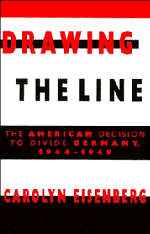Book contents
- Frontmatter
- Contents
- Preface and Acknowledgments
- Germany – Occupation Zones, 1945
- Introduction: Private Polowsky's Oath
- 1 Plans
- 2 Making Peace
- 3 The Limits of Reform: The U.S. Zone
- 4 A Fragile Friendship
- 5 The Russian Challenge
- 6 Bizonal Beginnings
- 7 The Doctors Deliberate
- 8 Marshall's Medicine
- 9 A Separate State
- 10 Cold War Germany
- 11 Winning
- Conclusion: The American Decision to Divide Germany
- Bibliography
- Index
Preface and Acknowledgments
Published online by Cambridge University Press: 07 October 2009
- Frontmatter
- Contents
- Preface and Acknowledgments
- Germany – Occupation Zones, 1945
- Introduction: Private Polowsky's Oath
- 1 Plans
- 2 Making Peace
- 3 The Limits of Reform: The U.S. Zone
- 4 A Fragile Friendship
- 5 The Russian Challenge
- 6 Bizonal Beginnings
- 7 The Doctors Deliberate
- 8 Marshall's Medicine
- 9 A Separate State
- 10 Cold War Germany
- 11 Winning
- Conclusion: The American Decision to Divide Germany
- Bibliography
- Index
Summary
Many years ago, when I first began teaching about the Cold War, I wondered why there were so few studies of the division of Germany. Although it seemed obvious that the German partition was one of the main elements in the emergence of the East–West conflict, the topic was somehow side-stepped in the scholarly literature.
Naively, I set out to write a book about U.S. policy and the division of Germany in the 1944–49 period. I quickly discovered why this was such an unpopular research subject. Not only were there tens of thousands of documents, scattered throughout governmental and private collections, but the issues were of daunting complexity. On the American side, virtually every important foreign policy actor had a hand in the German question and their decisions in this field were integrally connected to all the major policy questions of the time.
My effort to understand the events in Germany and the shaping of the postwar order has taken far longer than I ever imagined. When I began this book, the Cold War was taking on new and dangerous dimensions. As regards Germany, the NATO decision to place Cruise and Pershing II missiles in the western half seemed to highlight both the permanence and perils of partition. But then came the stunning changes of the late 1980s: the ascendancy of Gorbachev, the reversals in Soviet foreign and domestic policy, the collapse of the Berlin Wall, the reunification of Germany, the termination of the Cold War, and finally the disintegration of the Soviet Union itself.
- Type
- Chapter
- Information
- Drawing the LineThe American Decision to Divide Germany, 1944–1949, pp. ix - xiiPublisher: Cambridge University PressPrint publication year: 1996



